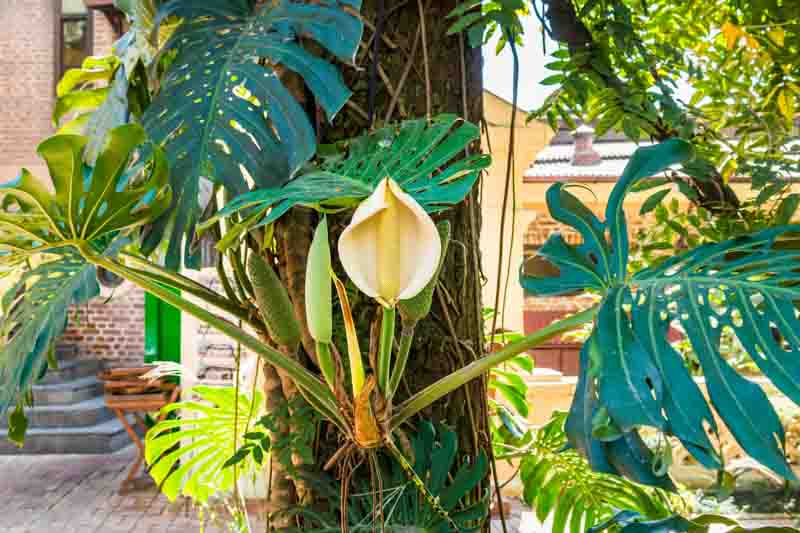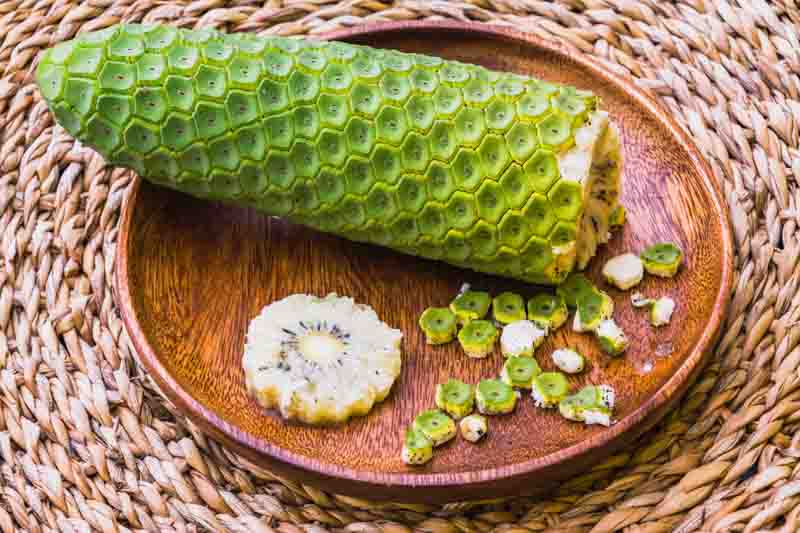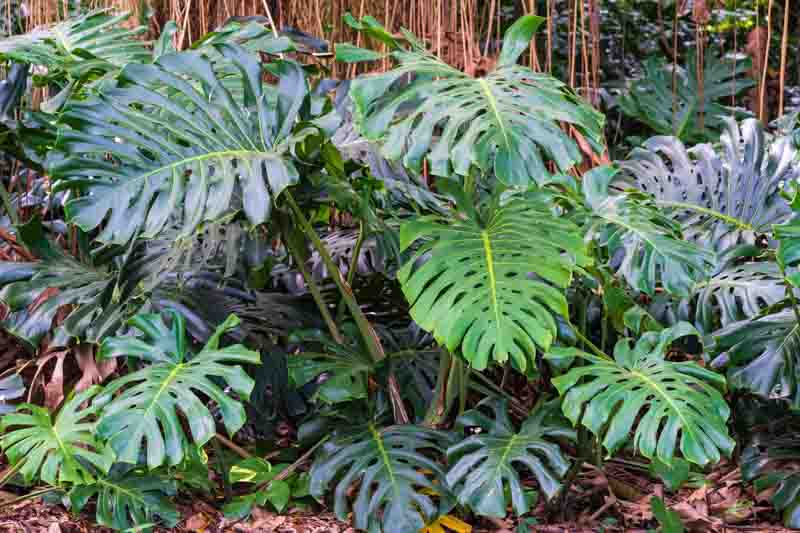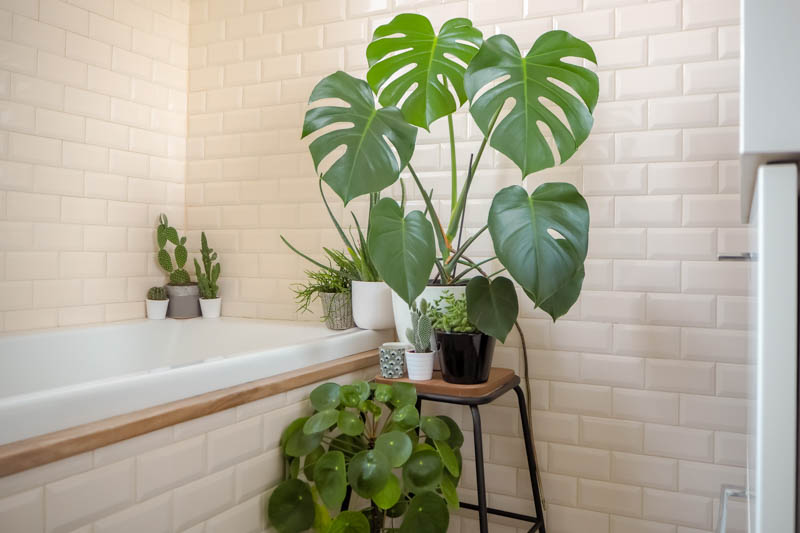Swiss Cheese Plant, Cheese Plant, Ceriman, Hurricane Plant, Split-Leaf Philodendron, Cutleaf Philodendron, Delicious Monster, Fruit Salad Plant, Fruit Salad Tree, Mexican Breadfruit. Philodendron pertusum
Monstera deliciosa, commonly known as the Swiss Cheese Plant, is a tropical perennial celebrated for its unique and dramatic foliage. Its iconic leaves, with natural holes and splits, have made it a popular choice for both indoor and outdoor gardening enthusiasts seeking a touch of the tropics.
Monstera deliciosa is characterized by its large, glossy, heart-shaped leaves that develop distinctive holes and splits as they mature. This natural fenestration, resembling Swiss cheese, contributes to its common name and aesthetic appeal.
Native: This plant is native to the tropical forests of southern Mexico, south to Panama. It thrives in the understory with dappled sunlight, which has adapted it well to indoor conditions. It belongs to the arum family (Araceae), along with Zantedeschia (Calla Lily), Caladium (Angel Wing), or Colocasia (Elephant Ear).
Plant Type and Habit: It is a climbing evergreen shrub. In its natural habitat, it uses aerial roots to climb trees, reaching for light through the dense foliage.
Size: In the wild, Monstera deliciosa can grow up to 70 feet tall (21 meters). Indoors, it typically reaches 6-8 feet (1.8 to 2.4 meters) in height and spread, with proper support for its climbing habit.
Flowers: The plant produces arum-like flowers seldom seen in indoor environments. The flower structure consists of a cream-colored spathe surrounding a spadix. Flowers give way to an edible fruit.

The Monstera fruit is a fascinating aspect of this popular houseplant. The fruit looks like a green ear of corn or a cone with hexagonal scales and takes about a year to mature fully on the plant. When ripe, the scales lift and reveal the edible part underneath, which has a sweet taste reminiscent of a mix of banana, pineapple, and mango. It’s important to wait until the fruit is fully ripe before consuming, as unripe Monstera fruit contains oxalic acid, which can be an irritant and cause discomfort if ingested. The ripening process naturally neutralizes these compounds, making the fruit safe to eat.
However, due to the plant’s common indoor use and the conditions required to flower and fruit, seeing and tasting a Monstera fruit is a rare occurrence for most plant owners.

The Monstera deliciosa leaf is a defining characteristic of this popular houseplant, celebrated for its unique and striking appearance. Each leaf is large, heart-shaped, and glossy, showcasing a deep green color. What sets these leaves apart are their natural fenestrations—holes and splits—that develop as the leaf matures. These perforations are thought to allow light to pass through to lower leaves in its dense, natural jungle habitat and to reduce wind resistance.
Initially, young leaves are solid and without holes, but as they grow, they develop these characteristic splits and holes, creating a distinctive “Swiss cheese” look that has captivated plant enthusiasts worldwide. The size of a mature leaf can be quite impressive, often measuring up to 3 feet (90 cm) or more in length and width, contributing to the plant’s dramatic visual impact.

Hardiness: Monstera deliciosa is hardy in USDA zones 10-12, thriving in warm, humid conditions.
Award: Recipient of the prestigious Award of Garden Merit of the Royal Horticultural Society.
Uses: Primarily used for ornamental purposes, it’s a popular indoor plant due to its air-purifying qualities and visual appeal. Outdoors, it can be used in landscaping in tropical or subtropical climates.
Toxicity: All parts of the plant are toxic except the ripe fruits. They are toxic to humans, cats, and dogs if ingested. They contain calcium oxalate crystals that can cause mouth and stomach irritation. Contact with the sap may cause skin irritation.
Deer and Rabbits: Its toxicity generally deters deer and rabbits.
Invasiveness: In suitable climates, Monstera deliciosa can become invasive if not managed, spreading through its aerial roots and overtaking spaces. It has become a mildly invasive species in Hawaii, Seychelles, Ascension Island and the Society Islands.
Benefits: Besides its decorative use, it’s known for purifying the air by removing pollutants, contributing to a healthier indoor environment.
Growing and caring for Monstera deliciosa, a striking tropical plant, is relatively straightforward, making it a popular choice for indoor gardeners.
Light: As a houseplant, Monstera thrives in bright summer light and winter direct sun. While it can grow under fluorescent lighting, insufficient light prevents the development of its characteristic leaf perforations.
Soil: Use a peat-based potting mix with perlite or sand to improve drainage. Monsteras prefer slightly acidic to neutral pH.
Water: Water when the top inch of soil feels dry. Monsteras like evenly moist soil but not soggy. Reduce watering in winter.
Temperature and Humidity: Ideal temperatures range from 68°F to 86°F (20°C to 30°C). Avoid exposure to temperatures below 50°F (10°C), as cold can damage the plant. Thrives in humidity levels of 60% or higher. Use a humidifier or mist the leaves regularly to increase humidity, especially in dry environments.
Fertilization: Apply a balanced, water-soluble fertilizer monthly during the growing season (spring through summer). Reduce to every other month in fall and winter.
Pruning: Prune in spring or early summer to maintain size and shape. Remove any yellow or damaged leaves to encourage new growth.
Cleaning: Dust the leaves occasionally with a damp cloth to ensure the plant can photosynthesize efficiently. This also keeps the plant looking its best.
Repotting: Repot every 2-3 years or when the plant becomes rootbound. Choose a pot 1-2 inches larger in diameter than the current one.
Climbing Support: Provide a moss pole or trellis for support, mimicking its natural climbing habit. Attach stems loosely to the support as they grow.

Propagating Monstera deliciosa is a rewarding and straightforward process that allows you to create new plants from an existing one.
Monstera deliciosa can encounter pests, diseases, and other common problems, especially when grown indoors.
Spider Mites: These tiny pests cause yellow stippling on leaves. Increase humidity and wash leaves with water or use insecticidal soap.
Mealybugs: Look for cottony deposits in leaf axils or undersides. Remove with alcohol-dipped cotton swabs or apply neem oil.
Aphids: Small, pear-shaped pests that cluster on new growth and undersides of leaves, sucking plant sap and weakening it. Combat them with a gentle spray of water, neem oil, or insecticidal soap to protect the plant’s health and appearance.
Scale insects: Hard, brown bumps on leaves/stems indicate scale. Scrape off manually and treat with neem oil or insecticidal soap.
Root rot: Overwatering can lead to root rot, characterized by mushy, brown roots and yellowing leaves. Ensure good drainage and allow soil to dry between waterings.
Leaf spot: Fungal or bacterial leaf spots appear as discolored patches on leaves. Improve air circulation, avoid wetting foliage, and treat with fungicides if severe.
Yellowing Leaves: Overwatering, poor drainage, or nutrient deficiencies can cause leaves to yellow. Adjust watering habits and consider repotting or fertilizing.
Brown Leaf Tips/Edges: Low humidity or drought stress might cause brown tips. Increase humidity around the plant with a pebble tray or humidifier.
Leggy Growth: Insufficient light can lead to sparse, leggy growth. Move your Monstera to a brighter location with indirect sunlight.
Fenestration Not Developing: Young plants or those not receiving enough light may not develop the characteristic leaf holes or splits. Provide brighter indirect light to encourage fenestration.
Indoors, Monstera deliciosa can grow up to 6-8 feet tall and wide, given adequate space and support for climbing. Outdoors, in its natural habitat or under optimal conditions, it can reach heights of up to 60 feet.
When grown outside in tropical or subtropical climates, Monstera deliciosa can reach impressive heights of up to 60 feet, especially when it has a tree or another structure to climb on.
Monstera deliciosa is naturally a climber. In the wild, it uses aerial roots to attach itself to trees, climbing upwards towards the light. When grown indoors, providing a moss pole or trellis can support its climbing habit.
Monstera deliciosa should be watered approximately every 1-2 weeks, allowing the soil to dry out between waterings. The frequency may vary based on the plant’s environment, such as light levels, temperature, and humidity. Overwatering can lead to root rot, so it’s crucial to check the soil moisture before watering again.
Yellowing leaves on a Monstera can be a sign of several issues, including overwatering, poor drainage, or a nutrient deficiency. It can also indicate that the plant is under stress from either too much direct sunlight or a lack of light. Assess care conditions to identify the cause and adjust as necessary.
Yes, Monstera deliciosa plants are toxic to cats. They contain calcium oxalate crystals, which can cause oral irritation, drooling, vomiting, difficulty swallowing, and other symptoms if ingested. It’s important to keep these plants out of reach of pets.
Yes, Monstera deliciosa plants are toxic to dogs. They contain calcium oxalate crystals, which can cause oral irritation, drooling, vomiting, difficulty swallowing, and other symptoms if ingested. It’s important to keep these plants out of reach of pets.
| Hardiness |
10 - 12 |
|---|---|
| Plant Type | Houseplants, Climbers, Shrubs |
| Plant Family | Araceae |
| Genus | Monstera |
| Exposure | Partial Sun |
| Season of Interest |
Spring (Early, Mid, Late) Summer (Early, Mid, Late) Fall Winter |
| Height |
6' - 70' (180cm - 21.3m) |
| Spread |
6' - 10' (180cm - 3m) |
| Maintenance | Low |
| Water Needs | Average |
| Soil Type | Loam, Sand, Chalk, Clay |
| Soil pH | Acid, Neutral, Alkaline |
| Soil Drainage | Moist but Well-Drained |
| Characteristics | Plant of Merit, Showy, Evergreen |
| Tolerance | Deer, Rabbit |
| Garden Uses | Patio And Containers |
| Hardiness |
10 - 12 |
|---|---|
| Plant Type | Houseplants, Climbers, Shrubs |
| Plant Family | Araceae |
| Genus | Monstera |
| Exposure | Partial Sun |
| Season of Interest |
Spring (Early, Mid, Late) Summer (Early, Mid, Late) Fall Winter |
| Height |
6' - 70' (180cm - 21.3m) |
| Spread |
6' - 10' (180cm - 3m) |
| Maintenance | Low |
| Water Needs | Average |
| Soil Type | Loam, Sand, Chalk, Clay |
| Soil pH | Acid, Neutral, Alkaline |
| Soil Drainage | Moist but Well-Drained |
| Characteristics | Plant of Merit, Showy, Evergreen |
| Tolerance | Deer, Rabbit |
| Garden Uses | Patio And Containers |
How many Monstera deliciosa (Swiss Cheese Plant) do I need for my garden?
| Plant | Quantity | |
|---|---|---|
| Monstera deliciosa (Swiss Cheese Plant) | N/A | Buy Plants |
Create a membership account to save your garden designs and to view them on any device.
Becoming a contributing member of Gardenia is easy and can be done in just a few minutes. If you provide us with your name, email address and the payment of a modest $25 annual membership fee, you will become a full member, enabling you to design and save up to 25 of your garden design ideas.
Join now and start creating your dream garden!
Create a membership account to save your garden designs and to view them on any device.
Becoming a contributing member of Gardenia is easy and can be done in just a few minutes. If you provide us with your name, email address and the payment of a modest $25 annual membership fee, you will become a full member, enabling you to design and save up to 25 of your garden design ideas.
Join now and start creating your dream garden!